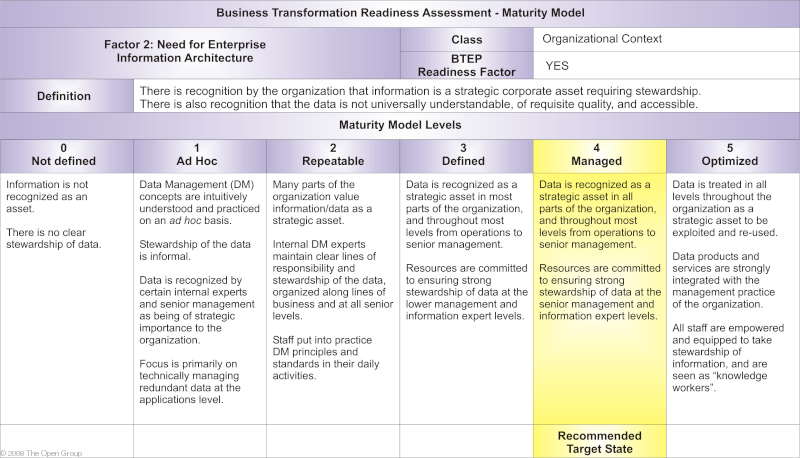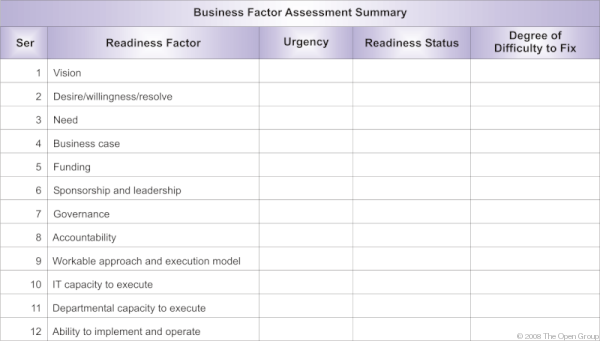
| You are here: | ||
| <<< Previous | Home | Next >>> |
This chapter describes a technique known as Business Transformation Readiness Assessment, used for evaluating and quantifying an organization's readiness to undergo change.
This chapter builds on work by the Canadian Government and its Business Transformation Enablement Program (BTEP).1
Enterprise architecture is a major endeavor within an organization and most often an innovative Architecture Vision (Phase A) and supporting Architecture Definition (Phases B to D) will entail considerable change. There are many dimensions to change, but by far the most important is the human element. For example, if the enterprise envisages a consolidation of information holdings and a move to a new paradigm such as service orientation for integrated service delivery, then the human resource implications are major. Potentially coupled with a change-averse culture and a narrowly skilled workforce, the most sound and innovative architecture could go nowhere.
Understanding the readiness of the organization to accept change, identifying the issues, and then dealing with them in the Implementation and Migration Plans is key to successful architecture transformation in Phases E and F. This will be a joint effort between corporate (especially human resources) staff, lines of business, and IT planners.
The recommended activities in an assessment of an organization's readiness to address business transformation are:
The Canadian Government Business Transformation Enablement Program (BTEP) provides guidance on how to identify the business transformation-related issues.
The BTEP recommends that all projects conduct a transformation readiness assessment to at least uncover the business transformation issues. This assessment is based upon the determination and analysis/rating of a series of readiness factors. The outcome is a deeper understanding of the challenges and opportunities that could be presented in the course of the endeavor. Many of the challenges translate directly into risks that have to be addressed, monitored, and, if possible, mitigated.
The following sections describe Business Transformation Readiness Assessment using the BTEP method, including some lessons learned. Readers should keep in mind that most organizations will have their own unique set of factors and criteria, but most are similar.
The first step is to determine what factors will impact on the business transformation associated with the migration from the Baseline to Target Architectures.
This can be best achieved through the conduct of a facilitated workshop with individuals from different parts of the organization. It is important that all perspectives are sought as the issues will be varied. In this workshop it is very useful to start off with a tentative list of factors that participants can re-use, reject, augment, or replace.
An example set of factors drawn from the BTEP follows:
Once the factors have been identified and defined, it is useful to call a follow-on workshop where the factors shall be assessed in some detail in terms of their impact/risk. The next section will deal with preparing for an effective assessment of these factors.
Once the factors are determined, it is necessary to present them in such a way that the assessment is clear and the maximum value is derived from the participants.
One such presentation is through the use of maturity models. If each factor is converted into a maturity model (a re-usable governance asset as well) accompanied by a standard worksheet template containing all of the information and deductions that have to be gathered, it can be a very useful tool.
The maturity model should enable participants to:
The care spent preparing the models (which is not insignificant) will be recouped by a focused workshop that will rapidly go through a significant number of factors.
It is important that each factor be well-defined and that the scope of the enterprise architecture endeavor (preliminary planning) be reflected in the models to keep the workshop participants focused and productive.
Circulating the models before the workshop for comments would be useful, if only to ensure that they are complete as well as allowing the participants to prepare for the workshop. Note that the model shown below also has a recommended target state put in by the enterprise architect; this again acts as governance.
An example of a maturity model is shown in Business Transformation Readiness Assessment - Maturity Model for one of the BTEP factors:

Ideally, the factors should be assessed in a multi-disciplinary workshop. Using a mechanism such as maturity models, enterprise architects will normally have to cover a great deal of ground in little time.
The use of a series of templates for each factor would expedite the assessment, and ensure consistency across the wide range of factors.
The assessment should address three things, namely:
The vision for a readiness factor is the determination of where the enterprise has to evolve to address the factor. First, the factor should be assessed with respect to its base state and then its target state.
For example, if the "IT capacity to execute" factor is rated as low, the factor should ideally be at "high" to realize the Target Architecture Vision. An intermediate target might be useful to direct the implementation. Maturity models are excellent vehicles to guide this determination.
Once the factor visions are established, then it is useful to determine how important each factor is to the achievement of the Target Architecture as well as how challenging it will be to migrate the factor into an acceptable visionary state.
The BTEP uses a Readiness Rating Scheme that can be used as a start point for any organization in any vertical. Each one of the readiness factors are rated with respect to:
Although a more extensive template can be used in the workshop, it is useful to create a summary table of the findings to consolidate the factors and provide a management overview. A like summary is shown in Summary Table of Business Transformation Readiness Assessment .

Once the factors have been rated and assessed, derive a series of actions that will enable the factors to change to a favorable state.
Each factor should be assessed with respect to risk using the process highlighted in Part III, 31. Risk Management , including an estimate of impact and frequency.
Each factor should be discretely assessed and a series of improvement actions outlined. Before starting anew, existing actions outlined in the architectures should be checked first before creating new ones.
These newly identified actions should then be formally incorporated into the emerging Implementation and Migration Plan.
From a risk perspective, these actions are designed to mitigate the risks and produce an acceptable residual risk. As risks, they should be part of the risk management process and closely monitored as the enterprise architecture is being implemented.
The assessment exercise will provide a realistic assessment of the organization and will be a key input into the strategic migration planning that will be initiated in Phase E and completed in Phase F. It is important to note whether the business transformation actions will be on the vision's critical path and, if so, determine how they will impact implementation. There is no point deploying new IT capability without employees trained to use it and support staff ready to sustain it.
The readiness factors, as part of an overall Implementation and Migration Plan, will have to be continuously monitored (Phase G) and rapid corrective actions taken through the IT governance framework to ensure that the defined architectures can be implemented.
The readiness factors assessment will be a living document and during the migration planning and execution of the Transition Architectures, the business transformation activities will play a key role.
The Architecture Definition should not be widely circulated until the business transformation issues are identified and mitigated, and the associated actions part of an overall "marketing" plan for the vision and the Implementation and Migration Plan.
For example, the consolidation of information holdings could result in hundreds of lost jobs and this vision should not be announced before a supporting business transformation/human resources plan is formulated to retrain or support the workers' quest for new employment.
The business transformation workshops are a critical part of the Communications Plan whereby key individuals from within the organization gather to assess the implications of transforming the enterprise. To do this they will become aware of the Architecture Vision and architecture definition (if they were not already involved through the business scenarios and Business Architecture). This group will feel ownership of the enterprise architecture, recognizing the enterprise architect as a valuable steward.
Their determination of the factors will again create a culture of understanding across the enterprise and provide useful insights for the Implementation and Migration Plan.
The latter plan should include a Communications Plan, especially to keep the affected personnel informed. In many cases collaborating with the unions and shop stewards will further assist a humane (and peaceful) transition to the target state.
In short, enterprise architecture implementation will require a deep knowledge and awareness of all of the business transformation factors that impact transitioning to the visionary state. With the evolution of IT, the actual technology is not the real issue any more in enterprise architecture, but the critical factors are most often the cultural ones. Any Implementation and Migration Plan has to take both into consideration. Neglecting these and focusing on the technical aspects will invariably result in a lackluster implementation that falls short of realizing the real promise of a visionary enterprise architecture.
The TOGAF document set is designed for use with frames. To navigate around the document:
Downloads of the TOGAF documentation, are available under license from the TOGAF information web site. The license is free to any organization wishing to use TOGAF entirely for internal purposes (for example, to develop an information system architecture for use within that organization). A book is also available (in hardcopy and pdf) from The Open Group Bookstore as document G091.